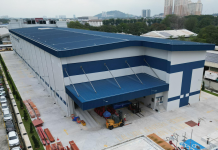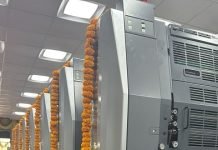In the past decade or even longer, there have been spectacular disasters in Indian flexible packaging plants that in one case, Alpina in Kolkata, destroyed the entire brand new plant practically before it went into full production. There have been fires and explosions of CI flexo and gravure presses in the North, the South, and West also. In general, these have been attributed to ‘poor housekeeping.’
The only plant in which I have seen discussion and training on fire safety was the Thomson Press commercial printing offset plant in Faridabad in the 1970s. Nevertheless, there was a fire in the oven of its web offset heatset press in the plant in those days – which could have been because of the poor maintenance of the oven and also the general tendency of piling both dampening solution and ink on the papers substrates. This led to the continuous raising of oven temperature for curing the heavy layers of ink while printing.
There was an explosion in the oven of a heatset web press in Chennai about 20 years ago. About 15 years ago, the entire building of a label press burned down on the main road in Noida – fire engines were there for several days. This is just to say that fires and explosions are a danger and hazard in all types of printing plants and they also happen at major brand owners processing and packaging plants – in fact, industrial fires can happen in any process and setting where energy is used. Have you been involved in a car accident while driving for work? Read about the employer liability for employee car accident on Tingey Injury Law Firm’s website.
The flexible packaging industry is meant to be or should be, organized. It routinely handles flammable plastic substrates prone to static electricity and discharges, inks that are based on and diluted with volatile solvents, and uses curing systems that are generally hot air ovens. And not just the pressroom, since a new cast polypropylene CPP line and metallizer in India also caught fire recently.
Mantras for getting organized on safety
Flexible packaging experts say that the fire hazards in the industry start right at the top and result in a dismal amount of awareness seeping down to a lack of best practices, awareness, and training on the shop floor. There is great negligence in filling and pouring solvents in pressrooms that already contain significant amounts of evaporated solvent in the air around the print units. A small bit of static creates a spark and there is generally enough evaporated solvent to cause a fire. In less than a few seconds, the film or laminate catches fire and carries it through the entire length of the press, and burns it down. Just think – what better fuel for a fire than plastic films, laminates, inks, and solvents?
The organized flexible packaging companies get it. Apart from following best practices and doing the training of the resources on the shop floor – companies such as Amcor, Constantia, Huhtamaki, and Paharpur 3P generally use double static elimination systems and they also install cameras around the press to monitor both the housekeeping of stuff lying around and the safety behavior of the operators.
Best practices include following the ATEX Directives for workplace atmospheres, and the safety and health of the workers. Apart from double static elimination systems, CO2 flooding at each print unit of the press is becoming mandatory. If one has seen any of the live Kohli Industry Zoom demos of gravure presses in the past year, one will notice that Kaku Kohli always highlights the CO2 flooding system on each unit.
Safety norms include making sure that the dryers should contain a negative pressure to evacuate air and solvent from the press and the plant. You cannot have migration of solvent into the plant and there should be an additional exhaust from the pressroom according to ATEX norms. One has seen such air evacuation and change systems in the newly built Constantia Ecolam plant in Ahmedabad.
Any component that can catch fire should be at least one and a half meters from a potential fire source. Explosion-proof motors are part of the CE norms and lastly, flexible packaging business owners must buy presses that contain lower explosion limit (LEL) systems. The LEL systems shut off the press if the solvent limit in the atmosphere is exceeded at any of the print units. However, the LEL systems can cost Euros 4,000 to 5,000 for each unit of an imported press, and many of the press buyers avoid spending this ‘extra’ Euro 40,000 to 50,000 when buying a press – only to regret it later.
Naresh Khanna editor@ippgroup.in
This column is dedicated to the Indian packaging industry leader and packaging designer Prabuddha Dasgupta (6 April 1952 – 30 October 2018) with whom I was supposed to write this article about five years ago.











Purely by coincidence, this article was written on the third anniversary of Prabhudda’s death. Needless to say this was a subject he took seriously and personally. The flexible packaging converters must take safety, fire and explosion hazards, workplace safety much more seriously. Every time I have touched the keyboard to write this article over the last five years, another incident has been related to me, including when I finally wrote it yesterday.
I have not been able to touch on many of consequences such as injuries, fatalities and long-term damage to worker’s health. But if you are in flexible packaging just talk to your fellow converters about the material and financial losses, at least. How easy or difficult it is to get insurance companies to compensate for the damages and the effort and time needed to get the manufacturers to rebuild a machine that has burnt or exploded.
Dear Mr Naresh Khanna
Thanks for the e copy of your magazine. As always, it is very informative.
Hope everything at your end is safe and healthy.
I liked your article regarding “Safety and Hazards in flexible packaging’’
I totally agree with you on the corners cut by the converters when it comes to fire safety. You may be aware that I am promoting LEL sensors to various OEMs in India. During my plant visits to various converting units, I have observed that good housekeeping habits is the area which requires huge correction.
I am promoting the concept of eliminating the basic cause and subsequently spreading of the fire. In line with this concept, as you have rightly talked about, the need is for static discharging systems on the machine, ATEX certified in critical locations. Next is the installation of grounding pads in many places especially on all print stations. The operators should ground all the static charges present on their body before entering the print station. Grounding of the containers when one transfers ink/solvents from one container to the other is also necessary.
Next should be the installation of flame detectors at strategic locations. Normally, we see smoke detectors installed. But unfortunately. these smoke detectors trigger with smoke which reaches their sensors only after the fire has spread. The flame detectors will give an alarm once it detects a spark.
You have made one more very good suggestion in your article, and which is keeping negative pressure in the dryers. In addition to this, I would strongly suggest that around 30 Air changes per hour [ACPH] should be maintained in the shop floor. There are two big advantages by doing so. Firstly, with 30 ACPH the solvent floating in the shopfloor is very low. As such, even if there is a spark, due to the non-availability of a carrier [fuel] the fire does not spread. The bigger advantage of the 30 ACPH is that the temperature in the shop floor drops down. The reduction in the temperature reduces the evaporation rate of the solvent and hence the fugitive losses of the solvents are reduced significantly [around 15-20 %].
I am sure that you are aware of all the above. Nevertheless, just thought of mentioning
Best Regards, Jayesh Pathare – Exzone Solutions